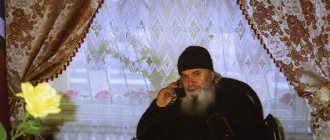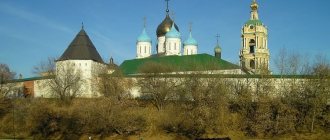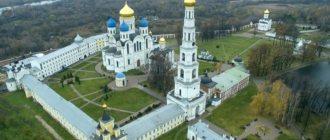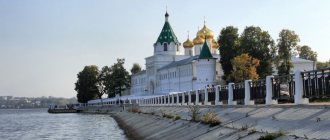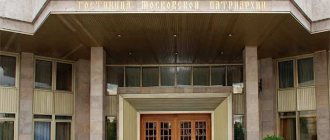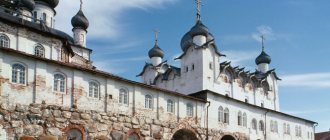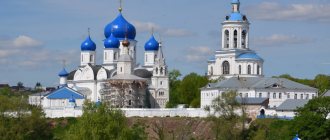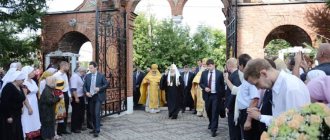"Save me, God!".
Thank you for visiting our website, before you start studying the information, please subscribe to our Orthodox community on Instagram, Lord, Save and Preserve † - https://www.instagram.com/spasi.gospodi/. The community has more than 60,000 subscribers. There are many of us like-minded people and we are growing quickly, we post prayers, sayings of saints, prayer requests, and timely post useful information about holidays and Orthodox events... Subscribe. Guardian Angel to you!
There are a large number of different religions in the world. Every person believes in something. And in order to find spiritual peace and gain strength, among believers there is such a custom as traveling to holy places. A large number of different monasteries are on the list of every Christian. Among the most revered are the Pskov-Pechersky Holy Dormition Monastery.
What's the best way to get there?
How to get to the Pskov-Pechersky Monastery from Moscow:
- take the daily train to Pskov;
- then either by taxi or by bus from the Pskov bus station via Pechki or Stary Izborsk to Pechory.
How to get to the Pskov-Pechersky Monastery from Pskov:
- your car;
- by bus No. 207 through Old Izborsk (flights daily, from 7:30 to 20:10);
- by bus from the bus station through Pechki (flights daily, from 8:30 to 22:00).
Visit. Operating mode
The territory of the Holy Dormition Pskov-Pechersky Monastery is limited to guest visits only a few days a year: this applies to caves (January 6–9 and August 26–29). Of course, it’s worth planning a visit to the monastery in advance. Otherwise, you won’t be able to see the caves of the Pskov-Pechersky Monastery or enter the temple: it’s better to tailor your visit to the services being held and the days of the week. This means that on Monday and Friday no one will be allowed into the Far Caves, and the Near Caves begin cleaning about an hour before the start of services in the monastery.
- excursions from 9 a.m. to 4 p.m.; someone conducts them every hour (either local bureaus or the monks themselves). The payment is donations. You need to sign up for excursions either by phone (up to 5 people) or by filling out an application form on the website (pilgrims).
- The appearance must be appropriate for the establishment: no uncovered parts of the body; for women, a covered head and a long skirt are required (take your own, in case those offered at the entrance are not enough for everyone).
- It is better to clarify what exactly you can photograph when entering the monastery.
- In addition to the excursion program and worship, you can get water from the Kornilievsky consecrated well .
- When the liturgy lasts, you can go to confession and communion in church .
- the Sretensky Church readily answers questions from guests from 10:00 to 18:00 .
Schedule of services
Monday and Friday
- morning prayer, liturgy, confession at 6:00 (Assumption Church);
- to order - prayer services and memorial services;
- confession at 9:00, liturgy at 10:00 (Sretensky Church);
- evening service at 17:00.
Tuesday
- morning prayer, liturgy, confession at 6:00 (Assumption Church);
- to order - prayer services and memorial services;
- confession at 9:00, liturgy at 10:00 (Cornilievsky Church);
- evening service at 17:00.
Wednesday
- morning prayer, liturgy, confession at 6:00 (Sretensky Church);
- to order - prayer services and memorial services;
- confession at 9:00, liturgy at 10:00 (Assumption Church);
- evening service at 17:00.
Thursday
- morning prayer, liturgy, confession at 6:00 (Assumption Church);
- to order - prayer services and memorial services;
- confession at 9:00, liturgy at 10:00 (St. Nicholas Church);
- evening service at 17:00.
Saturday
- morning prayer, liturgy, confession at 6:00 (Assumption Church);
- to order - prayer services and memorial services;
- confession at 9:00, liturgy at 10:00 (Sretensky Church);
- prayer to the Mother of God at 11:00 (Sretensky Church);
- All-night vigil at 17:00 (St. Michael's Church).
Sunday
- confession at 6:00, liturgy at 7:00 (Assumption Church);
- to order - prayer services and memorial services;
- confession at 9:00, liturgy at 10:00 (St. Michael's Church);
- evening service at 17:00.
Walls and towers
A defensive wall was built around the territory in the mid-16th century, when the Livonian War began. Today, 9 towers have been preserved, almost all of them are located on the banks of the ravine, but two, the Upper and Lower Grates, are at its bottom.
The Tower of the Upper Lattice is erected on a stream - it flows into the fortress. It housed 6 combat tiers, a patrol area and a guardhouse. This is the tallest tower: its size is 25 meters.
The Lower Lattice Tower has 4 tiers, with 7 loopholes on each. This made it possible to examine all the surroundings; from the third tier one could go out onto the fortress wall.
Where to stay
The distance from Pskov to the Pskov-Pechersky Monastery is 53 km, so both the city and the monastery itself offer many options for overnight accommodation.
- First of all, this is the Pilgrim's House hotel in Pechory (Yuryevskaya St., 82a). Donations serve as payment for food and cells, and buses take him to the monastery.
- “The Pilgrim’s Path” in Pechory (Mezhdunarodnaya St., 10). Prices for studios with biblical names start from 3,200 rubles. The monastery is just a stone's throw away.
- No less close to the monastery and from the private hotels “Pechory-Park”, “Your Bereg”, “Strannik” and “Planet” (5-10 minutes).
Post-war period
In January 1945, the Pechora region “withdrew” from Estonia, uniting with the Pskov region. The monastery was not closed, and it continued to operate on a par with the Trinity-Sergius Lavra: in this way, the Soviet government demonstrated “freedom of conscience.”
In the time remaining until the 90s, the monastery changed several leaders. One of them, Hieroschemamonk Sampson, was expelled due to a conflict with the Soviet regime and, after a short imprisonment, was tonsured into the great schema.
This is important: Alypiy began repairing buildings. Metropolitan John, who followed him, continued the restoration.
His successor, Abbot Alipiy, led the monastery during the reign of Khrushchev. Thanks to his efforts, the churches were not closed, and then, with the help of Germany, it was possible to return almost all the treasures taken away by the Nazis.
History of the Pskov-Pechersky Monastery
- Many people like the story of how local hunters found a number of caves in this area with an inscription as if from God. But in fact, the place became religious only in 1473 , when the monk Jonah dug into the hill and consecrated the Assumption Church. His successors built a temple and cells (already on the mountain), but the attack of the Livonians thoroughly devastated the monastery. The monastery never ceased to be attacked: it was as if they saw it as a defense of the Russian land.
- In the 16th century . The monastery became stronger thanks to the funds of patrons and the donated icon of the Mother of God “Assumption” . At this time, the monastery seems to be sliding down the mountain, settling in the valley. The fame and treasury of the monastery grew steadily; they were able to help the surrounding villages and ransom prisoners.
- The same century also gave the Pskov-Pechersky Monastery its defensive fame. Stefan Batory , assaults by the Livonian Order, Swedes, Lithuanian and Napoleonic troops were repelled
- Being on the territory of Estonia since 1922 , the monastery was slowly settling down. During World War II, she acted, helping captured Russians, intelligence officers and those in need. Since 1960 Restoration work has begun on the territory of the entire monastery complex, and the decoration of the buildings is gradually returning to life.
Historical reference
Back in the 14th century, Orthodox monks, trying to hide from the Tatars, settled in caves located near Pskov. Then the caves were abandoned, and they were discovered only in the 15th century. However, the official founding date of the monastery is considered to be 1473: at that time, the cave church of the Assumption of the Blessed Virgin Mary, which was excavated by Hieromonk Jonah, was consecrated. In wartime, to protect against attack, the monastery was fortified with high fortress walls.
It is noteworthy that throughout its centuries-old history the monastery has never been closed, and even in the period from 1920 to 1945. it functioned successfully, since at that time it fell under the jurisdiction of Estonia.
Architectural landmarks
The complex of the Pskov-Pechersky Monastery pleases with its color diversity: if you look at it in the photo, you can see the tints of yellow, white, red and again yellow. And besides color, the eye has something to focus on.
- Sources of holy water. Kornilevsky is covered with a dome, and Life-Giving is even hidden within the walls of the chapel of the early 20th century.
- Assumption Church. Founded in 1473, literally dug into the mountain. Its vaults are supported by 13 pillars, and inside are the remains of Abbot Cornelius, where services are held daily in his memory. The Intercession Church was built on top already in the 18th century. and is distinguished by 5 onion domes, designed in the same baroque style as the domes of the Kiev Pechersk Lavra.
- 2-tier stone belfry. There is a 16th century clock hanging in the tower, which makes a collection of no less ancient bells ring at certain times. They say that the clock used to play the melody “God Save the Tsar.” Now there are 17 bells, the largest of them are “Festive” with icons (1690), “Polyeleos” with animal ornaments (1598) and “Sentry” with prayers (1765). Small bells “Tinka” hang above them, and the middle bells (“Burlaki” and “Perebry”) are controlled by bell ringers. Among these bells there are creations of foundry workers of the 16th century.
- Sretensky three-domed temple, 1870 This white brick building houses icons of the Mother of God, the relics of monk Simeon and hosts services.
- St. Michael's Cathedral. It was completed in 1827 in memory of the next liberation of Pskov from enemies, receiving the name in honor of the patron saint of Orthodox warriors, Archangel Michael. The largest building, the dome of which is visible from a distance, is also distinguished by the fact that two shrines of the monastery are preserved inside it - the icon of the Mother of God “Tenderness” and the right hand of Tatiana.
- God-given caves. These are the words that were discovered on their arch in 1392. Later, the inscription was covered with masonry, but the name remained. There are Near Caves, where the remains of the first monks lie, and Far Caves, which are essentially cave streets-cemeteries with rows of memorial slabs (ceramides). Warriors, monks, pilgrims, righteous laymen and elders of the Pskov-Pechersky Monastery are buried here. People have been coming to the latter for help and intercession since ancient times. Among them are the hieroschemamonks Lazar, Simeon, Agapius, Pimen and John (Krestyankin).
- Holy Mountain. There is a garden here, there is a stone at which, according to legend, the first monk of the monastery prayed, and here there is a small traditional cell church, similar to a simple wooden hut.
- St. Nicholas Church. This stone church was founded by Cornelius over the holy gates, from which the “Bloody Path” of the Pskov-Pechersk Monastery originates. According to legend, it was from these gates to the Assumption Church that the body of the abbot was carried by Tsar Ivan the Terrible, who beheaded Cornelius out of rage, but repented.
- Walls and towers of the fortress. Due to fear of enemy raids and destruction, a stone fence surrounded the monastery in 1565. It is worth seeing with your own eyes the powerful walls 810 m long, in the middle of which there are 9 named towers.
Fate during the revolution and the Great Patriotic War
The monastery was lucky again at the beginning of the twentieth century: after the revolution it was given to Estonia, which saved it from destruction by Soviet power.
During the Second World War, the monastery suffered from artillery shelling - the Brotherhood Corps and the Refectory were destroyed.
Please note : according to some reports, it is known that the people the invaders were looking for were hiding under the domes of the cathedrals.
In an effort to protect themselves and the monastery, the monks maintained external loyalty to their enemies, gaining the opportunity to conduct an Orthodox mission in the occupied lands. However, this did not save it from ruin: more than 550 valuable items were taken away.
Shrines
- Icon of the Mother of God “Assumption”. It came to the monastery in 1521 and was painted by order of local residents. The icon is considered healing and is located in the Church of the Assumption.
- Icon of St. Nicholas the Wonderworker. Copied by the monk Cornelius himself in Moscow.
- Icon of the Mother of God “Tenderness”. A copy of the icon of the Vladimir Mother of God has been in the monastery since the time of Cornelius and participates in religious processions.
- The right hand of someone executed in Rome in the 3rd century. Tatiana. Donated to the monastery in 1977 after being kept secret for a long time in Russia.
The era of the Livonian and Northern Wars
The monastery is located 20 km from the Livonian fortress of Neuhausen, which became the reason for frequent raids by the Livonians. This became the reason for the strengthening of the monastery: at the beginning of the 16th century it received wooden walls, and in the second half of the century - stone ones. Heyday began: several temples that have survived to this day were built.
Interesting fact : Abbot Cornelius was killed by Ivan the Terrible, who, repenting, carried the dead man from the monastery gates to the Church of the Assumption. This road from St. Nicholas Cathedral to the Assumption Cathedral is called the “Bloody Path”.
The heyday continued for 1.5 centuries, until the signing of peace with Sweden - it was given power over the territories of Livonia. During this period, the fortress was besieged by the Polish king Stefan Batory, the Swedish kings Gustav II Adolf and Charles XII.
